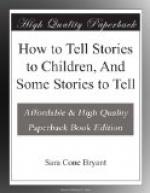The consideration of such familiar types and expressions as that of the ugly duckling suggests immediately another good reason for giving the child his due of fairy lore. The reason is that to omit it is to deprive him of one important element in the full appreciation of mature literature. If one thinks of it, one sees that nearly all adult literature is made by people who, in their beginnings, were bred on the wonder tale. Whether he will or no, the grown-up author must incorporate into his work the tendencies, memories, kinds of feeling which were his in childhood. The literature of maturity is, naturally, permeated by the influence of the literature of childhood. Sometimes it is apparent merely in the use of a name, as suggestive of certain kinds of experience; such are the recurrences of reference to the Cinderella story. Sometimes it is an allusion which has its strength in long association of certain qualities with certain characters in fairydom—like the slyness of Brother Fox, and the cruelty of Brother Wolf. Sometimes the association of ideas lies below the surface, drawing from the hidden wells of poetic illusion which are sunk in childhood. The man or woman whose infancy was nourished exclusively on tales adapted from science-made-easy, or from biographies of good men and great, must remain blind to these beauties of literature. He may look up the allusion, or identify the reference, but when that is done he is but richer by a fact or two; there is no remembered thrill in it for him, no savour in his memory, no suggestion to his imagination; and these are precisely the things which really count. Leaving out the fairy element is a loss to literary culture much as would be the omission of the Bible or of Shakespeare. Just as all adult literature is permeated by the influence of these, familiar in youth, so in less degree is it transfused with the subtle reminiscences of childhood’s commerce with the wonder world.
To turn now from the inner to the outer aspects of the old-time tale is to meet another cause of its value to children. This is the value of its style. Simplicity, directness, and virility characterise the classic fairy tales and the most memorable relics of folklore. And these are three of the very qualities which are most seriously lacking in much of the new writing for children, and which are always necessary elements in the culture of taste. Fairy stories are not all well told, but the best fairy stories are supremely well told. And most folk-tales have a movement, a sweep, and an unaffectedness which make them splendid foundations for taste in style.




